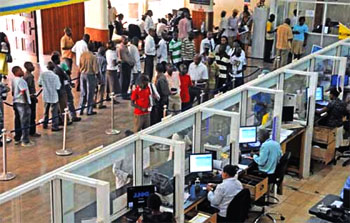

Ghana’s changing banking sector mirrors growing trends across Africa where indigenous banks are growing into regional banks and look set to outpace their century old European rivals in capturing market share.
While the old banking houses such as Barclays and Standard Chartered, which have been in Ghana for over 100 years are constrained by their foreign owners and thusly conservative in their lending and expansion, the new generation indigenous African banks are hungry for a greater and greater share of personal accounts from Africa’s growing middle class and business accounts from the continent’s burgeoning medium and small sized businesses.
All across Africa, this phenomenon is occurring and banks like Ecobank, Zenith, United Bank of Africa (UBA) among many others are paced to gain significant control over most of the banking sector’s deposits, assets and revenues. Even South Africa’s largest banks such as Standard Bank (Stanbic), First Rand Bank and Nedbank are yet to fully penetrate Africa. State banks like Ghana Commercial Bank are eventually likely to be privatised just as was the case of Ghana Telecom, if and when the government needs a major capital injection.
The growing role that indigenous banking institutions are playing to deepen financial intermediation comes into sharp focus as Africa stands poised to undergo a multi-decade long period of technological growth that will see many parts of the often beleaguered continent transformed into emerging markets with viable middle classes. According to the IMF, since 1995, systemic banking crises which occurred regularly in a half dozen countries almost every year since 1980 suddenly abated.
This improved structural stability of Africa’s overall banking sector – just at the time where most European banks have grown frail and overburden with debt, has allowed many of them to expand beyond their home countries into several more African countries. Further buttressing the financial sector expansion has been a period of marked improvement in fundamental macroeconomic indicators across Africa.
Africa’s indigenous banking institutions have in recent years surpassed their Western rivals by investing heavily in technology. New telecommunications technologies which have seen telephony coverage jump from below 10 per cent penetration in most countries in Sub-Saharan Africa to almost 55 per cent on average across the continent has helped to create the platform for the new indigenous financial architecture.
Between 1999 and 2004, the number of mobile phone subscribers in Africa jumped to 77 million, from 8 million, an average annual increase of 58 per cent. By 2011, Africa’s total subscribers had surpassed 539 million, giving Africa a more than a 55 per cent penetration rate. With over 500 million subscribers, Africa boasts of twice the number of cell phone users that the US, just as many subscribers as India in 2009 and China in 2007.
With the introduction of new telecommunications technologies, Africa’s growing financial institutions have been able to re-invent traditional ‘brick-and-mortar’ banking models. Equity Bank of Kenya has led the way in showing that with mobile telephony and collaboration with local grocers, a small defunct savings and loans bank can in a spate of 20 years become one of the largest banks in East Africa and control over 55 per cent of all personal bank accounts in Kenya despite facing more established rivals. Some of Equity Bank’s Kenyan rivals have been in existence for almost 100 years.
In Nigeria, Zenith Bank, another young bank established in 1990, has today grown to become the second largest bank in Nigeria. Both Zenith Bank in Nigeria and Equity Bank in Kenya and several other smaller banks that have grown in Africa over the past two decades and crushed their well-heeled competition have relied heavily on technology and cast away the condescending attitudes that Africa’s traditional bankers (often trained in ex-colonial educational and banking institutions) had historically portrayed to customers.
Today, another young bank, Ecobank, established in 1985 with an initial paid up capital of $32 million raised from 1,500 individuals is today Africa’s most geographically dispersed bank – with branches in 30 of Africa’s 54 countries.
While Zenith, Equity Bank, Ecobank and many similar indigenous African banks have literally taken over the continent, the traditional ex-colonial banks such as Barclays, Société Générale and Standard Chartered remain ensconced in few countries like Ghana, Cote d’Ivoire and Kenya.
While the new banks have won clients by requiring bankers to take off their stuffy coats and interact with regular customers, many of Africa’s ex-colonial banks have been unable to do so. While the risk management and governance processes at the old ex-colonial banks have been stellar and displayed in Nigeria in 2004 when the banking crisis came along, the anaemic growth of the traditional ex-colonial banks and their inability even in Nigeria to recover clients from the indigenous banks post the crisis signals that many will not survive the changing emerging financial services landscape in Africa. UBA, Zenith Bank and First Bank, all indigenous banks with more than 95 per cent of indigenously sourced deposits continue to dominate Nigeria’s banking sector.
Even despite the recent confidence-shaking Nigerian banking crisis, Standard Chartered in Nigeria has a mere one-fourth of the total deposits of Oceanic Bank, which was subsequently taken over by the Central Bank due to insolvency. Standard Chartered after a century of operating in Nigeria has only 26 branches, while Ecobank and Zenith have a combined branch network of over 900 branches. In short, Africa’s financial landscape is set to be dominated by the indigenous banks, while foreign banks wishing to participate may simply have to make major equity investments as Nedbank of South Africa has done with Ecobank, in order to compete.
Of the world’s other large banks, no Chinese bank has branches in Africa, despite a few having made investments into South African banks. UBS, Deutsche Bank and HSBC have a presence in only 1 country, South Africa. Citigroup is in a few more African countries, but has not been able to make any major headway. And yet as the recent global financial crisis has shown, and as the oncoming European monetary and fiscal crisis will dramatize more colourfully, unless Europe and America’s banks venture aggressively into growing territories like Africa, and other frontier markets they will continue to become obsolete.
The historic successes of Africa’s major indigenous banks notwithstanding, many are operating in weak domestic regulatory environments. Ecobank’s geographic reach into 30 countries may keep its risk managers awake at night, but Togo, where the banking super-house is headquartered does not have the regulatory capacity to properly supervise the group’s overall activities across Africa’s variegated regulatory and political systems. Mali equally does not yet have the capacity to oversee the UBA’s activities across several West African countries. With Mali’s own recent political chaos, there is not likely to be any traction on regulatory matters in the short to medium-term.
Political and regulatory risk assessments and monitoring, which many financial institutions consider an unnecessary luxury would in coming years become more important as Africa’s indigenous banks fan across the continent and become exposed to disjointed and multifarious legal, regulatory and socio-political systems. Simply satisfying Basel II capital requirements will not be enough. In coming years as these large multinational indigenous banks become more systemically important, the regulatory oversight of foreign parent companies will become even more important.























